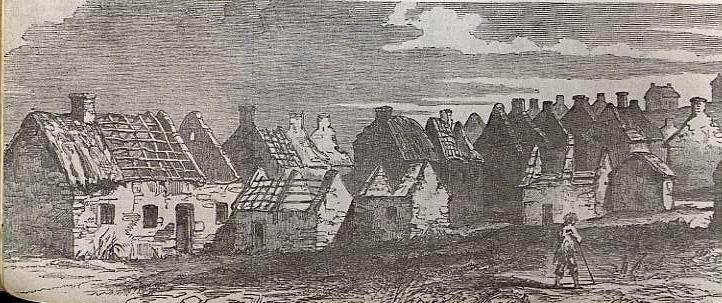| |
|
|
By 1801, the
population of Ireland was about 5 million. Forty years later in
1841 the census revealed a population of 8,175,124. (See census
page.) As the population grew, farms were subdivided and dwindled
in size. Many farming families
lived on potatoes and little else. In 1845, blight affected the
potato crop in widely separated areas. The following year it appeared
throughout the whole country. The potatoes rotted in the ground,
throughout the country the air was filled with the stench of the
rotting tubers, and many people faced starvation. farming families
lived on potatoes and little else. In 1845, blight affected the
potato crop in widely separated areas. The following year it appeared
throughout the whole country. The potatoes rotted in the ground,
throughout the country the air was filled with the stench of the
rotting tubers, and many people faced starvation.
Charles Tteveleyan permanent Head of Treasury
under Prime Minister Sir Robert Peel, introduced relief schemes
in the poorest areas to enable people to earn enough money to buy
maize that the government imported from the United States. Maize
is a grain which  needs
to be ground exceptionally finely to deliver its nutritional value,
the Irish did not have the means to do this, the coarsely ground
maize passing through their systems largely undigested. These measures
proved to be totally inadequate, and the next government, under
Lord John Russell, had to distribute food free of charge. But these
relief measures were also inadequate. Hundreds of thousands died,
along the roadsides or in their huts, where sometimes entire families
lay unburied, their corpses gnawed upon by stray dogs and rats.
In a hovel in County Mayo a old woman was found barely alive with
parts of the arms and face eaten off by rats, she died shortly after. needs
to be ground exceptionally finely to deliver its nutritional value,
the Irish did not have the means to do this, the coarsely ground
maize passing through their systems largely undigested. These measures
proved to be totally inadequate, and the next government, under
Lord John Russell, had to distribute food free of charge. But these
relief measures were also inadequate. Hundreds of thousands died,
along the roadsides or in their huts, where sometimes entire families
lay unburied, their corpses gnawed upon by stray dogs and rats.
In a hovel in County Mayo a old woman was found barely alive with
parts of the arms and face eaten off by rats, she died shortly after.
During the winter of 1847-8 it is estimated
that £17,000,000 worth of grain, cattle, pigs, flour, poultry
and eggs were exported to England, much of this may have been transshipped
to England's other overseas colonies. Also no relief from other
countries was allowed into Ireland unless it were carried in an
English ship, the Nation newspaper dubbed
this "British Commercial Christianity" During this period
tenants had no means with which to raise their rents which were
due twice yearly on 'Gale Day' Many landlords, particularly the
absentee ones had their tenants evicted and their houses demolished,
leaving them with neither food nor shelter. Josephine Butler an
Englishwoman living in Ireland at the time wrote. |
"Sick and aged, little children, and woman
with child were alike thrust forth into the snows of winter. And to prevent
their return their cabins were leveled to the ground. The few remaining
tenants were forbidden to receive the outcasts, the majority rendered
penniless by the famine, wandering aimlessly about the roads or bogs till
they found refuge in the workhouse or grave."
As a result of the Great Famine, the population
of the country dropped from 81/4 million to 61/2 million. It is believed
that a million people died of hunger and disease. And nearly a million
more  emigrated,
most of them to the United States and Canada. They left Ireland with bitterness
in their hearts, believing that Britain was the cause of all their suffering.
The poignant drawing on the left depicts a deserted village in the west
of Ireland, scenes like this were common in post famine Ireland. emigrated,
most of them to the United States and Canada. They left Ireland with bitterness
in their hearts, believing that Britain was the cause of all their suffering.
The poignant drawing on the left depicts a deserted village in the west
of Ireland, scenes like this were common in post famine Ireland.
Many books have been written about this period.
One particularly well researched and written is 'Paddys Lament'
by Thomas Gallagher, published by The Poolbeg Press Ltd.
Dublin.The Silent People by Walter Macken is perhaps one
of the best. Apparently Tteveleyan, after his retirement wrote his version
of the famine.
The famine  is
remembered in the traditional music of Ireland one particularly poignant
tune is Skibbereen a town in County Cork which was particularly hard hit
by the famine, click
to read the words and hear this haunting melody played on the Irish harp
by Rosemary Marr a musician from County Down. is
remembered in the traditional music of Ireland one particularly poignant
tune is Skibbereen a town in County Cork which was particularly hard hit
by the famine, click
to read the words and hear this haunting melody played on the Irish harp
by Rosemary Marr a musician from County Down.
Irish artists have produced many images
from the famine period, one particularly beautiful example displayed above
is entitled Emigrant Ship in Dublin Bay Sunset, by Edward Hayes, click
on the image for a larger view.
See also the famine of 1741
and Life on an Irish Farm) Ireland
also suffered famine in 1315-16 partly
as a result of the Bruce invasion and a famine which took hold in Europe
at the same time.
In 2007 tests crops of potatoes genetically modified
to resist blight are to be grown.
Go to History
of Ireland home page.
The following figures give a breakdown of the number
of citizens of foreign countries who reached America between 1820 - 1890
| Germany |
4,551,719 |
| Ireland |
3,501,683 |
| England |
2,460,034 |
| British North American Possessions |
1, 029,083 |
| Norway and Sweden |
943,330 |
| Austria-Hungary |
464,435 |
| Italy |
414,513 |
| France |
370,162 |
| Russia and Poland |
356,353 |
| Scotland |
329, 192 |
| China |
292,578 |
| Switzerland |
174,333 |
| Denmark |
146,237 |
| Total emigrants to America
1820-90 |
15,641,688 |
|
|

 farming families
lived on potatoes and little else. In 1845, blight affected the
potato crop in widely separated areas. The following year it appeared
throughout the whole country. The potatoes rotted in the ground,
throughout the country the air was filled with the stench of the
rotting tubers, and many people faced starvation.
farming families
lived on potatoes and little else. In 1845, blight affected the
potato crop in widely separated areas. The following year it appeared
throughout the whole country. The potatoes rotted in the ground,
throughout the country the air was filled with the stench of the
rotting tubers, and many people faced starvation.  needs
to be ground exceptionally finely to deliver its nutritional value,
the Irish did not have the means to do this, the coarsely ground
maize passing through their systems largely undigested. These measures
proved to be totally inadequate, and the next government, under
Lord John Russell, had to distribute food free of charge. But these
relief measures were also inadequate. Hundreds of thousands died,
along the roadsides or in their huts, where sometimes entire families
lay unburied, their corpses gnawed upon by stray dogs and rats.
In a hovel in County Mayo a old woman was found barely alive with
parts of the arms and face eaten off by rats, she died shortly after.
needs
to be ground exceptionally finely to deliver its nutritional value,
the Irish did not have the means to do this, the coarsely ground
maize passing through their systems largely undigested. These measures
proved to be totally inadequate, and the next government, under
Lord John Russell, had to distribute food free of charge. But these
relief measures were also inadequate. Hundreds of thousands died,
along the roadsides or in their huts, where sometimes entire families
lay unburied, their corpses gnawed upon by stray dogs and rats.
In a hovel in County Mayo a old woman was found barely alive with
parts of the arms and face eaten off by rats, she died shortly after. emigrated,
most of them to the United States and Canada. They left Ireland with bitterness
in their hearts, believing that Britain was the cause of all their suffering.
The poignant drawing on the left depicts a deserted village in the west
of Ireland, scenes like this were common in post famine Ireland.
emigrated,
most of them to the United States and Canada. They left Ireland with bitterness
in their hearts, believing that Britain was the cause of all their suffering.
The poignant drawing on the left depicts a deserted village in the west
of Ireland, scenes like this were common in post famine Ireland.